|
|
|
|

|
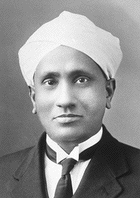
Sir.
C. V. Raman
(1888-1970)
 Find
more ...
Find
more ...
|
|
Sir
Chandrasekhara Venkata Raman
C.
V. Raman was born at Tiruchirapalli in South
India on November 7th, 1888. Raman entered
Presidency College, Madras, in 1902, and in
1904 passed his B.A. examination, winning the
first place and the gold medal in physics; in
1907 he gained his M.A. degree, obtaining the
highest distinction. Raman spent 15 years as a
Professor in Physics at Calcutta University
(1917-32), and 15 years as a Professor in
Physics at the Indian Institute of Science,
Bangalore (1933-48). In 1948, Raman became the
Director of the Raman Institute of Research at
Bangalore, established and endowed by himself.
On February 28, 1930, Chandrasekhar Venkata
Raman discovered the radiation effect
involving the inelastic scattering of light
that would bear his name- the Raman effect -
and which would win him Asia's first
Nobel Prize in any Science subject, in 1930.
Raman's research interests were in optics and
acoustics - the two fields of investigation to
which he dedicated his entire career. The main
investigations carried out by Raman were: his
experimental and theoretical studies on the
diffraction of light by acoustic waves of
ultrasonic and hypersonic frequencies
(published 1934-1942), and those on the
effects produced by X-rays on infrared
vibrations in crystals exposed to ordinary
light. Raman was elected a Fellow of the Royal
Society early in his career (1924), and was
knighted in 1929. Besides, Raman was honoured
with a large number of honorary doctorates and
memberships of scientific societies. C. V.
Raman passed away in 1970.
|
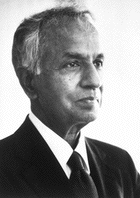
Prof.
S. Chandrasekhar (1910-1995)
 Find
more ...
Find
more ...
|
|
Prof.
Subramanyan Chandrasekhar
Born in Lahore, India, in 1910, theoretical
astrophysicist Chandrasekhar was elected to
the National Acadamy of Sciences (USA) only
two years after he became a US citizen in
1953. Chandrasekhar was noted for his work in
the field of stellar evolution, and in the
early 1930s he was the first to theorize that
a collapsing massive star would become an
object so dense that not even light could
escape it. Although this finding was greeted
with some skepticism at the time it was
announced, it went on to form the foundation
of the theory of black holes, and eventually
earned Chandrasekhar a shared Nobel Prize in
physics for 1983. Chandrashekhar estimated the limit (Chandrashekhar limit) on the size of a highly dense variety of star known as 'White Dwarf'. If this star's mass exceeds the limit, it explodes to become a bright supernova. He also made significant contributions to understanding the atmosphere of stars and the way matter and motion are distributed among the stars in the galaxy. Chandrashekar, who recieved the Nobel Prize in 1983, was honoured this year when the largest x-ray telescope aboard the US Space Shuttle was named 'Chandra Telescope'.
In addition to his work on
star degeneration, Chandrasekhar contributed
important theorems on the stability of cosmic
masses in the presence of gravitation,
rotation, and magnetic fields; this work
proved to be crucial for the understanding of
the spiral structure of galaxies. From the
time he came to the US in 1936 until his death
in 1995, Chandrasekhar was affiliated with the
University of Chicago and its Yerkes
Observatory. Chandrasekhar passed away in
1995.
|
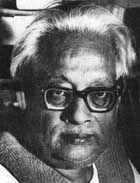
Prof.
S.
Bose
(1894-1974)
 Find
more ...
Find
more ...
|
|
Prof.
Satyendranath Bose
Satyendranath
Bose was born on the first of January 1894
in Calcutta. He studied at the University of
Calcutta, then taught there in 1916, taught
at the University of Dacca (1921-45), then
returned to Calcutta (1945-56). He did
important work in quantum theory, in
particular on Planck.html's black body
radiation law. Bose sent his work Planck's
Law and the Hypothesis of Light Quanta
(1924) to Einstein. He wrote a covering
letter saying:- Respected Sir, I have
ventured to send you the accompanying
article for your perusal and opinion. You
will see that I have tried to deduce the
coefficient .. in Planck's law independent
of classical electrodynamics. It was
enthusiastically endorsed by Einstein who
saw at once that Bose had removed a major
objection against light quanta. The paper
was translated into German by Einstein and
submitted with a strong recommendation to
the Zeitschrift f�r Physik. Bose also
published on statistical mechanics leading
to the Bose-Einstein statistics. Dirac
coined the term boson for particles obeying
these statistics. Satyendranath Bose and
Albert Einstein published a series of papers
on the physics of particles with integer
spins (bosons). The duo predicted that if a
collection of bosonic atoms could be cooled
to the point that each one reaches its
lowest possible quantum mechanical energy, a
Bose-Einstein condensate would result. In
this state, atoms would lose their
individual properties and would act
collectively as a single entity.
Satyendranath Bose passed away in 1974.
|
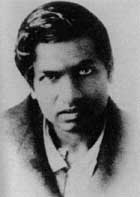
Ramanujan
(1887-1920)
 Find
more ...
Find
more ...
|
|
Srinivasa
Iyengar Ramanujan
Srinivas
Ramanujan was born on December 22, 1887 in
his grandmother's house in Erode, Tamil Nadu.
In January 1913 Ramanujan wrote to G. H.
Hardy having seen a copy of his 1910 book
Orders of Infinity. In Ramanujan's historic
first letter to Hardy, he introduced himself
and his work of about 100 theorems. In 1914,
Hardy brought Ramanujan to Trinity College,
Cambridge, to begin an extraordinary
collaboration between two mathematicians. On
16 March, 1916 Ramanujan graduated from
Cambridge with a Bachelor of Science by
Research (the degree was called a Ph.D. from
1920). Ramanujan's dissertation was on
Highly Composite Numbers and consisted of
seven of his papers published in England.
Ramanujan would go on to publish 26 papers
in British journals. On May 2, 1918,
Srinivasa Iyengar Ramanujan was elected
Fellow of the Royal Society of London. He
would be the first Indian and first Asian to
be elected so. Srinivasa Ramanujan was one
of India's greatest mathematical geniuses.
He made substantial contributions to the
analytical theory of numbers and worked on
elliptic functions, continued fractions, and
infinite series. Ramanujan's work on partial
sums and products of hypergeometric series
led to major development in the topic. He
gave his name to two constants, the Landau-Ramanujan
constant and the Nielsen-Ramanujan constant.
Ramanujan died on April 26, 1920 at the age
of 33 in Kumbakonam, Tamil Nadu. Before he
died, Ramanujan wrote down about 600
theorems on loose sheets of paper, which
were discovered and published only in 1976
as the "Lost Notebook" of
Ramanujan.
|
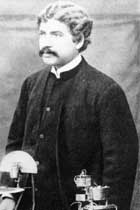 Sir.
J. C. Bose
(1858-1937)
 Find
more ...
Find
more ...
|
|
Sir Jagdish Chandra Bose
Born in Mymensingh, Bengal, in November 30, 1858, Bose went to England to study medicine at the University of London. He returned to India with a B.A degree from Cambridge and a B.Sc from the London University and started experiments involving refraction, diffraction and polarisation. Sir J.C. Bose did his original scientific work in the area of Microwaves.
He produced extremely short waves and done considerable improvement upon Hertz's detector of electric waves. He produced a compact appratus for generating electromagnetic waves of wavelengths 25 to 5 mm and studying their quasioptical properties, such as refraction, polarization and double refraction. Bose turned his attention from electromagnetic waves to response phenomena in plants by the end of the 19th century. Bose's research on response in living and non-living led to some significant findings: in some animal tissues like muscles, stimulation produces change in form as well as electrical excitation, while in other tissues (nerves or retina), stimulation by light produces electric changes only but no change of form. He showed that not only animal but vegetable tissues under different kinds of stimuli-mechanical, application of heat, electric shock, chemicals, drugs- produce similar electric responses. He was appointed Professor Emeritus after he retired from the Presidency College in 1915. The Bose Institute was founded a couple of years later. He was also elected Fellow of the Royal Society in 1920. In 1937 Jagdish Chandra Bose passed away at Giridih in Bihar.
|
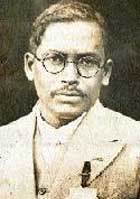 Meghnad
Saha
(1893-1956)
 Find
more ...
Find
more ...
|
|
Meghnad Saha
Meghnad Saha was born on October 6, 1893 in Sheoratali, a village in the District of Dacca, now in Bangladesh. In 1911, he came to Calcutta to study in Presidency College. Meghnad became famous after his article on solar chromosphere ion' was published in 'Astrophysical journal' in 1920. He came to be recognised as a scientist of substance. In 1920, he went to England to prove his theory before the global scientific community. He went to Prof. Alexander Fowler and Prof. Walter Nurnst of Germany. Two years later, he came back and joined the University of Calcutta as the Khaira Professor. In 1927, Meghnad was elected as a fellow of London's Royal Society.He invented an instrument to measure the weight and pressure of solar rays. He produced the famous equation which he called 'equation of the reaction - isobar for ionization' which later became known as Saha's "Thermo-Ionization Equation". Saha was the leading spirit in organizing the scientific societies like the 'National Academy of Science' (1930), 'Indian Institute of Science' (1935) and the 'Indian Association for the Cultivation of Science' (1944). The lasting memorial to him is the 'Saha Institute of Nuclear Physics' founded in 1943 in Calcutta. He was the chief architect of river planning in India. He prepared the original plan for Damodar Valley
Project. Saha passed away in 1956.
|
|
|
|
|
|
|
 Top
of the page Top
of the page  1
1 
|
|
|
|


